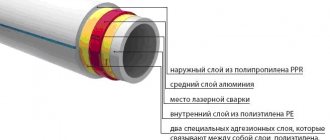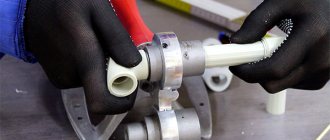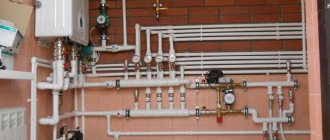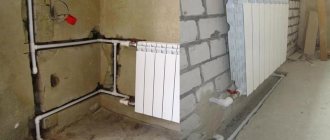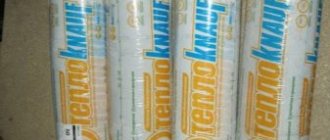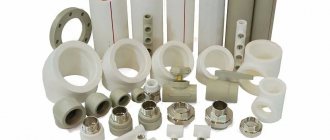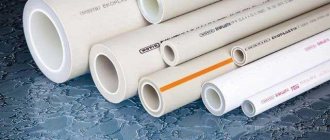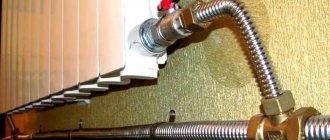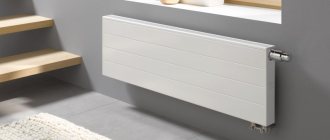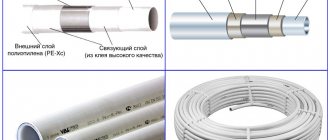Each product has its own letter and number designations.
This is necessary to separate them from each other, both by visual characteristics and by technical level parameters. PVC pipes were no exception to the rule. Manufacturer, terms and features of operation are not a complete list of what can be found out only by looking at information such as the marking of polypropylene pipes.
What properties do different types of polypropylene pipes have?
Polypropylene is a thermoplastic synthetic non-polar polymer. The polymerization method using a Ziegler-Natta catalyst was invented in 1957, and since then the production of products with an isotactic structure characterized by high strength
, heat resistance and a high degree of crystallinity.
Polypropylene is a material that is resistant to acid, alkaline and saline solutions, as well as other inorganic substances. It does not absorb liquid and retains its electrical insulating properties over a wide range of temperatures.
Based on polypropylene, various modified materials are produced, such as thermoplastic, high-strength plastic and other environmentally friendly products. Recycling and recycling are a technological process, due to which polypropylene is actively displacing products made from other types of plastics from the world market.
Polypropylene melts at a temperature of +164…+170 °C
, Brinell hardness ranges from 40 to 70 MPa, brittleness temperature - from
-10 to -15 ° C
, tensile failure stress (kgf/cm2) - from 250 to 400, flexural modulus of elasticity (kgf) - from 6700 to 11900 .
A huge number of products that are popular on the market today are made on the basis of sheet propylene. To produce this material, the extrusion method is used. Depending on the shade, smoothness and other factors, sheets are divided into two classes. They are used for the production of pipeline systems, connecting them together in different ways, one of which is welding.
Polypropylene and its properties
Polypropylene (PP) is a polymer that is part of the group of thermoplastics, that is, substances whose properties change depending on the ambient temperature.
At 140 °C, products made from this type of plastic soften, and at 170 °C they melt. The maximum temperature for their use is 120 °C.
However, to be on the safe side, manufacturers usually indicate a permissible temperature of 90-95°C, since the combination of elevated temperature (115-120°C) with high pressure 6-7 kgf/m2 can be dangerous
When using PP products, it is important to take into account that this type of plastic has pronounced thermal expansion. At high temperatures, polymer parts can expand significantly, for example, the length of a three-meter pipe increases by 3 cm.
Types of polypropylene pipes
Polypropylene (accepted international designation - PP) has been used for quite a long time for the manufacture of pipes as a base material. However, only the development of modern technologies has made it possible to obtain products that can be used for hot water supply and heating systems.
Polypropylene itself is characterized by its pronounced inertness to the chemical effects of a possible liquid coolant medium. However, in terms of heat resistance and strength, different types can differ significantly from each other.
So, pipes made of this material are divided into three main types, which have their own designations:
PP-N are intended for cold water only
- PP-N is the first type of polypropylene pipes, inert to chemical influences, but not resistant to elevated temperatures. Therefore, they are intended for cold water supply, sewerage, drainage systems, ventilation and other applications where elevated temperatures are not expected. Very often, this type of pipe is prevalent for industrial production lines, as it is highly resistant to increased internal pressure.
The range of possible applications of PP-V pipes is somewhat wider, but for heating they are still “weak”
- PP-B is the second type of polypropylene pipes, which has all the same advantages of PP-N, but, in addition, has the ability to withstand temperature loads of low amplitude. Therefore, they can be installed on separate main sections of “warm floor” systems. And also in hot water supply circuits, provided that the water or coolant does not heat above 50 degrees.
However, the main scope of application of PP-B is different. Most often, such pipes are used for sewer systems, since the material from which they are made has a sufficient degree of impact strength and heat resistance for this area.
Only PPR pipes are fully suitable for heating systems
- PPRC, PPR or PP-3 is the most advanced type of pipes that is used in hot water supply and heating systems, that is, where temperatures can exceed 50 degrees and there is a possibility of increased compression loads. Increased heat resistance and mechanical strength are achieved thanks to special production technologies, in which ethylene molecules are introduced into the molecular lattice of propylene during synthesis.
PPR are pipes that are most widely used in domestic conditions, as they have a pronounced resistance to internal pressure and temperature changes.
Polypropylene pipes (PPR), used in domestic conditions, in turn, are divided into several types, depending on resistance to baric loads: PN -25; PN -20; PN -16; PN -10. Their main characteristics are given in the table:
| Type of polypropylene pipes | Nominal working pressure | Scope of pipe use | |
| MPa | technical atmospheres (kgf/s²) | ||
| PN-10 | 1 | 10.21 | Connection to the “warm floor” circuit, the coolant in the system of which has a temperature of no higher than 45 ° C, or cold water supply. This type of pipe is designed for a system pressure of no more than 1 MPa. It is the most affordable due to its rather low performance characteristics. |
| PN-16 | 1.6 | 16.32 | Cold and hot water supply with a temperature of no more than 60˚C and a pressure of no more than 1.6 MPa. |
| PN-20 | 2 | 20.40 | Cold and hot water supply in an autonomous system with low pressure and no water hammer. The coolant temperature for this type of product should not exceed 80˚C, and the pressure should not exceed 2.0 MPa. |
| PN-25 | 2.5 | 25.49 | Hot water supply and heating with coolant up to 90÷95˚С, including in the central heating system. The pressure for which they are designed is 2.5 MPa. |
Each type of pipe is produced in a fairly wide range of diameters, internal and external: on which the wall thickness depends
| Outer diameter, mm | PN-10 | PN-16 | PN-20 | PN-25 | ||||
| Internal Ø, mm | Wall thickness, mm | Internal Ø, mm | Wall thickness, mm | Internal Ø, mm | Wall thickness, mm | Internal Ø, mm | Wall thickness, mm | |
| 16 | — | — | 11.6 | 2.2 | 10.6 | 2.7 | — | — |
| 20 | 16.2 | 1.9 | 14.4 | 2.8 | 13.2 | 3.4 | 13.2 | 3.4 |
| 25 | 20.4 | 2.3 | 18 | 3.5 | 16.6 | 4.2 | 16.6 | 4.2 |
| 32 | 26 | 3 | 23 | 4.4 | 21.2 | 5.4 | 21.2 | 3 |
| 40 | 32.6 | 3.7 | 28.8 | 5.5 | 26.6 | 6.7 | 26.6 | 3.7 |
| 50 | 40.8 | 4.6 | 36.2 | 6.9 | 33.2 | 8.4 | 33.2 | 4.6 |
| 63 | 51.4 | 5.8 | 45.6 | 8.4 | 42 | 10.5 | 42 | 5.8 |
| 75 | 61.2 | 6.9 | 54.2 | 10.3 | 50 | 12.5 | 50 | 6.9 |
| 90 | 73.6 | 8.2 | 65 | 12.3 | 60 | 15 | — | — |
| 110 | 90 | 10 | 79.6 | 15.1 | 73.2 | 18.4 | — | — |
Naturally, the values of diameters and wall thicknesses directly affect the resistance of pipes to temperature and pressure, which, in principle, determines the duration of their possible operation in certain conditions:
| Coolant temperature ˚С | Service life, years | Pipe type | |||
| PN-10 | PN-16 | PN-20 | PN-25 | ||
| Permissible excess pressure (kgf/cm²) | |||||
| 20 | 10 | 13.5 | 21.7 | 21.7 | 33.9 |
| 25 | 13.2 | 21.1 | 26.4 | 33 | |
| 50 | 12.9 | 20.7 | 25.9 | 32.3 | |
| 30 | 10 | 11.7 | 18.8 | 23.5 | 9.3 |
| 25 | 11.3 | 18.1 | 22.7 | 28.3 | |
| 50 | 11.1 | 17.7 | 22.1 | 27.7 | |
| 40 | 10 | 10.1 | 16.2 | 20.3 | 25.3 |
| 25 | 9.7 | 15.6 | 19.5 | 24.3 | |
| 50 | 9.2 | 14.7 | 18.4 | 23 | |
| 50 | 10 | 13.9 | 17.3 | 23.5 | 21.7 |
| 25 | 8 | 12.8 | 16 | 20 | |
| 50 | 7.3 | 11.7 | 14.7 | 18.3 | |
| 60 | 10 | 7.2 | 11.5 | 14.4 | 18 |
| 25 | 6.1 | 9.8 | 12.3 | 15.3 | |
| 50 | 5.5 | 8.7 | 10.9 | 13.7 | |
| 70 | 10 | 5.3 | 8.5 | 10.7 | 13.3 |
| 25 | 4.5 | 7.3 | 9.1 | 11.9 | |
| 30 | 4.4 | 7 | 8.8 | 11 | |
| 50 | 4.3 | 6.8 | 8.5 | 10.7 | |
| 80 | 5 | 4.3 | 6.9 | 8.7 | 10.8 |
| 10 | 3.9 | 6.3 | 7.9 | 9.8 | |
| 25 | 3.7 | 5.9 | 7.5 | 9.2 | |
| 95 | 1 | 3.9 | 6.7 | 7.6 | 8.5 |
| 5 | 2.8 | 4.4 | 5.4 | 6.1 | |
The data presented in the tables is the result of long-term testing of pipes under various conditions, which even theoretically may arise during their operation, so it is worth taking them into account in the process of selecting the required material.
Polypropylene pipes can have different colors, but when choosing them you should not pay special attention to it (perhaps only from an aesthetic point of view) since the external color does not in any way determine the characteristics of the products and does not affect their quality.
A red or blue stripe may be applied to the surface of some pipes - it serves as a specific indicator of the purpose of a particular type. Thus, blue color is applied to cold water supply pipes, and red indicates the ability of the products to withstand elevated temperatures in the hot water system or heating circuit.
When purchasing pipes, be sure to pay attention to their markings.
In addition to colored stripes, the pipes are marked with letters, which indicate their characteristics and intended purpose for installation in certain water supply or heating systems, and you also need to pay attention to it. The meaning of the marking indicators corresponds to the information given in the tables.
As can be seen from the presented characteristics, PN-20 products are optimally suited for the heating system, but the ideal option would still be PN-25 pipes, which have pronounced resistance to elevated temperatures and pressure, even with a good margin.
Additional tips, some features
Pipes with the thinnest walls are designated PN10. They are only suitable for systems with heated floors or for supplying cold water.
At the same time, they can withstand a nominal operating pressure of at least 1.0 MPa. 20-100 millimeters is equal to the outer diameter.
Pipelines marked PN25 are distinguished by the presence of a layer located on the outside.
The use of glue is no longer necessary when joining layers due to the fact that there was perforation on the surface of the foil. The connection helps improve stability and strength properties. Can be used for hot water supply and heating.
Supplying PN25 with aluminum foil ensures that the products have a low coefficient of thermal expansion. But there are also difficulties associated with installation. Ideal for heating and, accordingly, for hot water supply.
Advantages of polypropylene
Long service life is the main positive feature for such products. But this result is achieved only by those who fully follow the recommendations from the manufacturers.
The operating time does not change if the temperature in the system increases, but only for a short period. Markings and sizes also affect this.
Video: designation of polypropylene pipe products
Marking of plastic pipe Sojet Elfin I + Elan 25A
Some installation tips
There are a number of other advantages:
- Minimal maintenance. They do not need to be painted; their appearance lasts for a long time.
- Light weight, resulting in minimal problems during transportation. And installation requires the involvement of a minimum number of workers.
- Reduced installation time compared to metal products.
- Good sound absorption, thanks to which the coolant passes through the system silently.
- Resistance to even the most severe temperature changes. Low thermal conductivity, virtually eliminating condensation.
- No corrosion on the surface in the internal part. This makes it possible to leave such characteristics as the internal diameter unchanged.
Video: designation of PP pipe products
Webinar “Plastic and metal-plastic pipes PE-X and PE-RT”
Marking of polypropylene pipes
When choosing polypropylene pipes, in addition to the PP type and the presence of reinforcement in the marking, you must also look at the maximum operating pressure. According to GOST, this parameter is designated PN and a number from 10 to 25.
Marking of polypropylene pipes
Depending on this designation, PPR pipes are distinguished as follows:
- PN10 – thin-walled for cold water and “warm floors” with water up to +450C.
- PN16 – universal for cold water and hot water supply up to +600C.
- PN20 – thick-walled for water with temperatures up to +950C.
- PN25 – with reinforcement for hot water supply and heating (also up to +950C).
For a short period of time, one or another PPR pipe for water supply can withstand exceeding the specified temperatures. But with prolonged excessive heating, it will gradually begin to collapse. And as a result, its service life of half a century declared by manufacturers will be significantly reduced.
Welding and heating time of polypropylene pipes
About numeric and alphabetic characters
A lot of letters and numbers are applied to this material. Manufacturers usually open official websites, where, among other things, there is information on the labeling and the information that it represents. But it is best to translate these explanations into a language that everyone can understand.
There are several characteristics that are indicated by the designation of polypropylene pipes.
- Pressure. Unit of measurement – kg\cm2. Denoted as PN. Shows how long the pipe operates normally while maintaining certain characteristics.
The thicker the wall, the higher this indicator is likely to be. For example, they produce brands PN20, PN25. Such options are needed for supplying hot water and heating systems.
Sometimes red or blue stripes are also applied. This will make it clear what kind of water future pipelines are intended for.
- The marking of polypropylene heating pipes includes data related to materials and structure. Large tables are compiled to describe this parameter. But it is enough to be aware of the basic symbols to carry out the correct installation of heating in an ordinary building.
- Al - aluminum.
- PEX is a designation for cross-linked polyethylene.
- PP-RP. This is polypropylene that supports high pressure.
- PP - Common varieties of polypropylene material.
- HI – fire-resistant products.
- TI - thermally insulated version.
- M – designation of multi-layering.
- S – icon for single-layer structures.
Marking of polypropylene pipes for water supply may also indicate data that relates to:
- The presence or absence of certificates.
- Issued batch numbers, serial designation and time, and so on. Such designations may consist of 15 characters or more.
- Manufacturers.
- Wall thickness and section.
Thanks to this information, each buyer himself will choose a water supply material that satisfies all his needs.
Main pipe diameters according to GOST
The diameter in the marking of PPR water pipes is indicated as the outer diameter. Moreover, the larger it is and the higher the PN, the thicker the pipe wall. Products of 16–20 mm are used for installing water pipes throughout the apartment and cottage. 25–32 mm is for the riser. Larger diameter options are intended for pipelines in multi-storey buildings, main networks and sewerage.
How to correctly calculate the diameter of a pipe based on its purpose
Conclusions and useful video on the topic
The presented video will tell and show you how to navigate a wide range of plastic products intended for heating communications.
When choosing products made of polypropylene, you need to get acquainted with their characteristics in order to accurately determine how well a pipe of one type or another suits the purpose you need.
As a rule, product descriptions contain technical characteristics of products, and also indicate their intended purpose, which allows you to make an error-free choice.
Have you selected polypropylene pipes, but have doubts about their quality? Ask our experts and users for advice - many experienced home craftsmen will be able to share their own experience in operating a plastic heating circuit.
Or maybe you have theoretical knowledge on the topic of the article and want to supplement the material we have presented? Leave your comments, add recommendations - they will be useful for beginners.
Aluminum reinforcement
There are solid and perforated reinforcement with aluminum foil.
Continuous reinforcement with aluminum foil is the most economical option for reinforced pipes.
In this case, a thin layer of aluminum is located between the layers of propylene, due to which the structure of the pipe is significantly strengthened. But these types of products, as well as others, are distinguished by a number of limitations in operation:
- the water temperature should not reach +60 °C, otherwise the pipe may become deformed and burst if overheated;
- all joints should be cleaned before soldering, which will significantly reduce the time spent on installing the system;
- the temperature at which aluminum-reinforced pipes freeze is only -5 °C. Therefore, when using this type of polypropylene pipe in a private house, it is strictly forbidden to turn off the heating;
- Experts do not recommend using these types of products to supply hot water, since due to constant temperature changes, the aluminum layer may collapse over time.
Aluminum perforation means a mesh with small holes. During the extrusion of polypropylene pipes, viscous material enters the perforations, thereby ensuring adhesion between the polymer and metal.
Thanks to aluminum reinforcement, the coefficient of thermal expansion is significantly reduced. However, some difficulties may arise during the installation of engineering systems. When socket welding, the aluminum shell and outer layer of polymer are first removed, and the pipe is cleaned to an amount that corresponds to the depth of its insertion into the fitting.
There are types of polypropylene pipes that do not require removal of the outer layer during installation. They, in turn, also have some disadvantages:
- Only the outer layer of the product, equal to half the wall thickness, is attached to the fitting;
- a nozzle for welding equipment is required;
- After you cut the pipe, it will need to be trimmed.
Glass fiber reinforcement
Types of pipes marked PPR-FB-PPR consist of two layers of polypropylene, between which fiberglass is located, which is why this product is called a “fiberglass” pipe.
A pipe reinforced with glass fiber compares favorably with a product with aluminum reinforcement:
- installation does not require calibration and cleaning;
- material and time costs are reduced due to the fact that the soldering procedure is similar to the connection of solid plastic pipes or other stripped polymer products;
- a pipe reinforced with fiberglass does not delaminate because it has a homogeneous structure;
- Glass fiber increases the rigidity of the pipes.
The disadvantage of a fiberglass pipe is that its thermal expansion is 6% higher than that of products with aluminum reinforcement.
Internal reinforcement with polypropylene
These types of products are essentially metal-plastic pipes, the outer layer of which is made of polypropylene. Such pipes are resistant to high temperatures.
The disadvantages of this type of polypropylene pipes are characterized by:
- multilayer - the presence of adhesive joints of two different materials;
- attaching only the outer layer of the product to the fitting;
- the possibility of contact of reinforcement with the transported medium.
Metal-polymer polypropylene pipes
Modern types of polypropylene pipes are distinguished by a classic five-layer metal-polymer construction, shown in the figure below:
This type of polypropylene pipes is used for water supply and heating systems.
Modern polypropylene products have a multilayer construction, just like metal-plastic products. The only difference is that for a classic metal-plastic pipe, PEX or PE-RT polyethylene is used as a polymer, and not polypropylene.
Below is a small table that will help you understand the technical characteristics of all types of polypropylene pipes and the features of their application:
| Types of reinforcement | Specifications | ||||
| Maximum temperature, °C | Minimum temperature, °C | Thermal expansion, deformation | Maximum pressure, atm | Scope of application | |
| Solid aluminum | 60 | 5 | Average | 1 | Cold water system |
| Perforated aluminum | 70 | 10 | Average | 1.5 | Open type heating |
| Fiberglass | 90 | 20 | Low | 2 | Hot water supply system, heating, heated floor |
| Composite | 95 | 20-30 | Absent | 2,5–3 | Any |
Correct selection of raw materials. We simplify installation
A non-reinforced polypropylene-based tube is the simplest and most convenient option to use. They have a homogeneous structure, which allows them to be installed together with any type of connection.
Structures with fiberglass reinforcement are also quite convenient. The material melts well and does not require additional processing.
You can give some advice to those who are just planning to purchase products.
- Aluminum requires mandatory stripping if it is located on the outer layer at the joint. Otherwise, it will not be possible to create a tight, high-quality connection. It will not be possible to bring the polypropylene layer from the outside to “gluing” due to the compensatory foil. But this does not mean that such pipe products cannot be used at all. This inconvenience can be easily eliminated with special tools.
- Tubes equipped with internal reinforcement also require stripping. Just get rid of the aluminum foil. And make a cut at a right angle so that the work is successful. The exception is not polypropylene pipes reinforced with fiberglass, the markings of which will give clues.
MANUFACTURERS OF POLYPROPYLENE PIPES
Domestic and foreign manufacturers offer a wide selection of high quality polypropylene pipes. Moreover, the products of Russian concerns (Valtec, Pro Aqua) are not inferior to foreign brands.
| Manufacturer | Polypropylene material | Operating temperature, ºC | Working pressure, bar | Outer diameter, mm | Wall thickness, mm | Service life, years |
| Valtec (Russia) | PPR | 70-95 | 9-25 | 20-110 | 2,8 — 8,3 | 50 |
| BANNINGER (Germany) | PP-RST, PP-RCT, PP-RCT, PP-R CT | -10 +95 | 0-10 | 20-110 | 2,3-15 | 50 |
| Ecoplastic FIBER (Netherlands) | PP-RCT | up to +70 | 6-35 | 20-125 | 2,5-4.0 | 50 |
| About Aqua (Russia) | PP-R | -10 +100 | 0-10 | 20-125 | 3,4-20,8 | 50 |
In our company you can order Valtec products. It is used for external and internal communications and has an optimal combination of price and quality. As the official distributor of this Russian-Italian manufacturer, we have the opportunity to offer you Valtec PP pipes and fittings at a better price than our competitors.
Regulations
In addition to GOST standards, the pipe may contain various DIN and ISO standards - standards of other countries, in particular those where the brand comes from. This does not mean at all that a pipe with European standards was produced in Europe - many products are made in China, under European brands. In general, if a pipe is supplied to Russia, then it must comply with a number of GOST standards (links at the end).
Often, pipes are sold on store shelves that do not comply with GOST standards at all - here we can only advise you to pay attention to these points and not trust the quality of such a product. Sometimes on the pipes there are inscriptions in English “for heating only, not for drinking water” - apparently the plastic releases harmful substances that are contraindicated for drinking water. Therefore, it is recommended to translate unclear inscriptions.
And finally, let’s decipher the inscription on the pipe from the first photo: PP-ALUX PP-R100/AL/PP-R100 32×5.4 PN25 SDR6/S2.5 CLASS5/9 BAR GOST R 53630-2015
. This is a pipe reinforced with aluminum foil, three layers: polypropylene random copolymer on the outside and inside, foil in the middle. The outer diameter of the pipe is 32 mm. with a wall thickness of 5.4 mm. The pipe can be used for 50 years in cold water with a pressure of 25 bar. The ratio of diameter to wall thickness is 6, size series is 2.5. The pipe can be used for a long time at all 5 classes with a pressure of up to 9 bar (classes 1,2,3 and 4 have higher pressure, you need to look at the documentation). The product meets all parameters from GOST R 53630-2015.
Sources:
GOST 32415-2013 Pressure pipes made of thermoplastics and connecting parts for them for water supply and heating systems. General technical conditions
GOST R 53630-2015 Multilayer pressure pipes for water supply and heating systems. General technical conditions
GOST ISO 4065-2005 Thermoplastic pipes. Table of universal wall thicknesses (with amendment)
Characteristics of PPR pipes and scope
Each PPR product is marked with encrypted data on the diameter and wall thickness, operating pressure, service class, pipe material and much more.
There are several modifications of polypropylene, each of which has its own operating characteristics:
- PPH – products made from homopolymer, used exclusively in cold water supply.
- PPV pipes are made of block copolymer, the scope of application is cold water supply and installation of heated floors.
- PPR is the most common material - a random copolymer of polypropylene, used in the installation of heated floors, for hot water supply and water heating.
- PPs – polypropylene with improved heat-resistant properties, rarely used in domestic water supply systems.
For cold water supply and drinking water supply, it is enough to use PN10 pipes made of homopolymer, since the low temperature environment practically does not cause linear expansion, and the pressure in the household pipeline is below 1 MPa.
In heating systems and for supplying hot water, it is advisable to install reinforced pipes with fiberglass or aluminum foil (basalt fiber has only recently appeared on the pipe market and has not yet gained much popularity).
Reinforcement in a hot water pipeline is necessary as it restrains the linear expansion of polypropylene and prevents deformation of the pipes. Products with an aluminum layer can be used in any conditions, since the metal foil provides additional rigidity without practically increasing the outer diameter. Fiberglass is best used indoors.
Important! If the pipeline section will pass through open air, it must be protected from ultraviolet rays. The ideal solution would be to use a polyurethane foam shell.
What about areas of application?
There are other designations as well. Some of them are able to show where and how to install a pipeline from a particular material.
Typically this designation takes the form of a schematic drawing. Marking of reinforced polypropylene pipes is no exception.
The following is a complete list of areas of application.
- For systems providing fire protection.
- In shipbuilding
- For sports facilities.
- To irrigate farmland.
- For use in industrial infrastructure.
- For heating, warm floors and walls.
- In water supply systems.
- With heating pipelines.
- For drinking water pipelines.
Polymers have become especially widespread and have become an integral part of our lives. Labeling of plastic pipes for water supply also cannot be done without them.
The main reasons for choosing polypropylene pipes for the heating circuit
The reasons, which, in fact, are the advantages of polypropylene pipes are as follows:
- Polypropylene has a distinctly low weight, which greatly simplifies its delivery to the work site and installation itself - no special devices or equipment are required.
- If you have the necessary tools, polypropylene pipes are easy to install, and welding techniques can be learned very quickly.
- The manufacturing material is absolutely harmless for residential premises, since it does not change its chemical composition even with strong heating and does not emit toxic fumes into the air.
- Thanks to the stabilizers included in polypropylene, pipes can withstand water hammer and thermal loads, and even freezing of water inside without rupture.
- The smooth inner walls of the pipes promote uniform, turbulence-free and noise-free circulation of the coolant.
- Both the pipes themselves and their components are inexpensive. A wide selection of components allows for installation of a circuit of any complexity.
A little training and any owner can carry out independent installation
- A circuit made of high-quality pipes, if installed correctly, will last at least 20–30 years.
- The aesthetic appearance of the pipes makes it possible not to spoil the interior, and the contour itself usually does not require either painting or additional decoration.
So, polypropylene pipes with a reinforcing aluminum layer are excellent for heating circuits of autonomous and central systems. In addition, the installation of this material is quite simple and feasible even for people who have no experience in such work. After several training sessions on the installation of individual components, the assembly process of the entire circuit can be carried out on your own.
Advantages of polypropylene pipes
Products made from this type of polymer have many advantages:
- have a complete structure without a longitudinal seam;
- plastic parts do not corrode;
- are light in weight, facilitating transportation and storage;
- can be used even at high pressure;
- easy to install, which allows you to assemble the structures yourself, without the involvement of professionals;
- polypropylene products can be used for a long time (50 years or more);
- the cost of such elements is lower than their analogues (steel, metal-plastic);
- have low thermal conductivity, which reduces heat loss to a minimum;
- do not freeze at sub-zero temperatures;
- they create virtually no hydraulic resistance, which allows the water flow to move without noise and vibration;
- polypropylene products are considered environmentally friendly, they do not emit harmful substances, and the water does not acquire foreign odors;
- such elements are hygienic: polymers do not contribute to the development of single-celled plants and microbes;
- Products made from polypropylene have an aesthetic appearance; they do not require painting or other finishing.
However, to take advantage of all these benefits, you need to choose the right pipes for water supply or heating.
Which PPR pipes are more convenient to install?
The easiest and fastest way to install, of course, is single-layer polypropylene pipes. For installation it is enough:
- cut the product with a hacksaw or pipe cutter,
- rub away burrs on the edges,
- connect structural elements using a fitting or special glue (liquid welding).
We recommend that you read: Replacing old pipes with polypropylene on your own
The principle of installing multilayer PPR pipes is the same, however, in this case cold welding is not suitable, since it will only glue the outer layers and will not provide a reliable connection.
Therefore, multilayer pipes are best connected by hot welding or using special multilayer threaded fittings.
Attention! Do not attempt to thread a pipe or fitting yourself. There is a high probability that the resulting threads will not match, which means the connection will not be airtight. It is better to buy fittings with ready-made standard threads.
Pipes with aluminum reinforcement require special preparation before installation. If layers of fiberglass pipes are literally soldered into each other, then aluminum foil is connected to polypropylene using glue, which means there is a possibility of delamination.
To avoid this negative consequence, before welding PPR pipes with aluminum reinforcement, it is necessary to remove a small section of foil and solder the inner and outer layers of polypropylene together. Thanks to this action, water will not be able to penetrate between the layers, which means there will be no threat of deformation and destruction of the pipeline.
Welding heating pipes
To weld elements, you must use a special soldering iron, the regulator of which is set to 270 °C.
Features of choosing soldering temperature
When soldering, it is important to take into account the ambient temperature: if the process takes place outside or in a cold room, the nozzle will cool down quickly.
Although reinforced products have better performance characteristics (strength, durability), they are somewhat more difficult to install than conventional single-layer elements
For comfortable work in this case, it is better to increase the duration of the process or increase the welding temperature. It is advisable to lengthen the soldering time also in the case of connecting PP pipes with a large diameter. We provided detailed information on soldering temperature with examples of specific values in this article.
Step-by-step instructions for welding pipes
To solder two sections of pipe made of polypropylene, it is necessary to perform a number of operations.
To cut polypropylene pipes, you can use special scissors, as well as a hacksaw or an electric jigsaw (in the latter case, it is important to remove the chips)
First of all, you need to measure the bottom of the pipe, and then cut it with a special tool - a pipe cutter. If a part reinforced with aluminum is used for installation, it is necessary to first remove the top and middle layers. Burrs are also removed from the cleaned and cut end of the element.
Using a marker on the pipe, the depth of the planned insertion of the fitting is marked. To prevent narrowing of the passage, it is necessary to provide a small (1 mm) interval between the protrusion and the end of the fitting. The connection point is marked with a marker on the surface of the pipe and the fastening component.
The elements are simultaneously placed on two nozzles of the welding machine and heated up for 5 seconds (the period can be increased when using large parts). After they are sufficiently warmed up, the workpieces must be removed from the nozzles and connected according to the applied marks, pushing them towards each other and pressing evenly (but not screwing them in, as this may damage the layer).
It is important to control the fasteners from all sides to prevent distortions in the radial/axial directions. The coupling should smoothly reach the side, as a result of which an annular bulge, the so-called flange, will appear on the pipe.
The seam cools down for 10-30 seconds, during which it is necessary to check the uniformity of the flanging and, if necessary, make a small correction of the connection.
After this, you can proceed to another stage of work, the plan of which is best developed in advance.
The use of PP pipes that are unsuitable for the heating system or the wrong choice of diameter can lead to fatal consequences - rupture of the product
When carrying out welding work with plastic pipes, it is important to prevent overheating of the workpieces, which can be easily determined by the darkening of the material. At excessively high temperatures, polypropylene can melt and clog the pipe, blocking the inside.
To avoid mistakes when soldering and disastrous consequences as a result, we recommend that you familiarize yourself with the rules of welding.
PPRC aluminum reinforced
Among all polypropylene risers, the most reliable is PPRC pipe reinforced with aluminum. The product can function even at temperatures of +115⁰С – +120⁰С
, without expanding at all.
If necessary, the pipeline can be efficiently operated at higher temperatures. But there is no need to abuse this, even if the manufacturer provides a certain margin of safety for these products.
A solid or perforated aluminum layer is joined with glue, which provides the structure with less strength, but reduces expansion during heating.
What is the secret of aluminum reinforcement?
It's all about the structure of the product: the presence of foil prevents thermal expansion. Therefore, structures made from aluminum-reinforced parts are often used for the installation of high-temperature water or steam heating systems. Although they are successfully used in the construction of hot and cold water supply lines.
The design provides for several ways to place metal in polypropylene pipeline elements. To do this, the foil is joined end-to-end or overlapping, closer to the inner surface, to the middle or on the outer side. Products are also produced with perforated foil.
The properties of pipe products are determined by the foil layer
1. With external reinforcement, installation of products becomes more difficult. At the same time, it will take more time to set up the system, since it takes 20-25 seconds to clean the top layer of products.
Important!
Stripping products from foil (facing pipes) is a very important and necessary step before welding products, since failure to perform this procedure may cause pipe destruction. 2. When reinforced with solid foil, the possibility of oxygen penetrating inside the system is completely eliminated.
This prevents the onset of corrosion processes in metal network elements. In this case, high-quality gluing of the polypropylene layer with a reinforced coating is required. Otherwise, moisture may seep through the polymer, and drops of water may appear on the foil, which will lead to the destruction of the riser. Important!
Choose the highest quality pipe products that are manufactured by reputable companies. 3. When using perforated type of foil, the connection becomes better.
But in this case, it is possible for air to penetrate inside the system. The best option is to place perforated foil between the inner and outer walls of polypropylene. In this case, the possibility of deformation of the elements in the event of heating, as well as the penetration of air into the coolant, is eliminated.
How to choose the right size of polypropylene fittings for your home line
Selecting elements for your home highway is not difficult if you read the markings correctly. The necessary characteristics of the product are described in sufficient detail; most of the terms are explained above. All you need to do is select models that are compatible with each other.
Supply ventilation in an apartment: why is it needed and which one is better to install?
The best option would be to go to a plumbing store and look at products from one manufacturer. If you do this, the risk of incompatibility is reduced. In addition, you can touch the product there, and this, in turn, is a good way to check compatibility. In order to do this, you just need to insert the edge of one product into another. If it fits tightly, then the models fit together.
Main purpose
Due to the special properties of polypropylene, the scope of application of pipes made from this material is quite wide.
They are used in the installation of hot and cold water supply systems, for heating, sewage and ventilation systems, installation of heated floors, in technological lines of food and chemical production, irrigation systems, etc.
In this case, the laying of pipes can be carried out in an open or closed way: inside walls under various finishing materials, in channels and shafts; pipes can be laid directly underground - in general, there are a lot of installation options.
Advantages
Thermoplastic polymer products for pipelines have an impressive list of advantages.
These include:
PP pipe design
- sufficient mechanical strength and resistance to sudden changes in pressure or temperature;
- high environmental friendliness of materials and aesthetic design;
- chemical resistance to aggressive environments and toxic substances;
- high dielectric properties that prevent electrical conductivity of the material;
- good noise absorption (polypropylene muffles the vibrating and rumbling sounds that the coolant makes as it flows through the pipeline);
- high anti-corrosion properties and absence of deposits inside the pipes;
- the elastic properties of the material prevent water from freezing, which ensures reliable operation and long service life of the heating system; the highest reliability of connections among other types of plastic pipes;
- a wide range of different types of connecting and shut-off valves, allowing the installation of pipeline systems of any configuration and complexity;
- convenience, simplicity and speed of installation;
- light weight, low cost of materials and connecting elements;
- low maintenance and long service life.
Flaws
Disadvantages relate to the operating features of the product:
Bending a pipe using a gas torch
- The low heat resistance of the material requires you to approach the choice of PP pipes very carefully (you need to take into account the heat resistance indicator or immediately look for insulation for heating pipes).
- Polypropylene is difficult to deform, making it impossible to change the direction of the pipe. It is necessary to resort to the help of additional fittings (angles, tees, contours).
- Quite high linear expansion when heated (especially for unreinforced pipes) requires the use of special installation rules and special compensators.
- To lay pipes, you need a special welding machine, which, due to its design, cannot always be used in limited space or in hard-to-reach places.
- Polypropylene is exposed to direct sunlight - this causes premature aging of the material.
Pipe service class
Pipe service class. This is another useful parameter that will make our life easier when choosing a pipe. Unfortunately, it is not always indicated. But if it is indicated, then you don’t have to worry about calculating the lifespan, but just look at the table. There are 5 classes:
For convenience, I put them in a separate table:
Many who see this sign for the first time try to understand how to operate the pipe according to the service class and get confused. The fact is that earlier I said that the lower the temperature inside the pipe, the longer its service life.
And when a person looks at the 5th class of operation, he sees that at a temperature of 20 degrees the pipe will last only 14 years. This suggests that you are not reading the table correctly. The fact is that all the values that are indicated here must be added.
At a temperature of 80 degrees, the pipe will live for 10 years. At a temperature of 60 degrees, the pipe will live for 25 years. At a temperature of 20 degrees, the pipe will live for 14 years. This does not mean that the pipe will live only 14 years, only 10 years and only 25 years. This means that at a combination of these temperatures the pipe will last 49 years.
Plus here I add another 1 year of operation at an emergency temperature of 90 degrees. And another 100 hours at 100 degrees
In total, we get that a pipe of class 5 operation at a pressure of 6 bar can last 50 years.
If we talk about class 2 operation, then everything is very simple:
Temperature 70 degrees. The lifespan at this temperature is 49 years. Maximum temperature 80 degrees - 1 year. And the emergency temperature is 95 degrees - 100 hours.
The pressure is indicated on the pipe opposite each service class.
In my case, a pipe of class 1 and 4 can be operated at 10 bar.
At the second 8 bar
and fifth grade 6 bar. (CLASS 1/10bar, 2/8bar, 4/10bar, 5/6bar)
